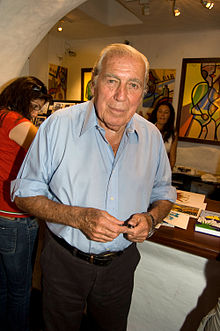Carlos Páez Vilaró
| Carlos Páez Vilaró | |
|---|---|

Carlos Páez Vilaró in 2009.
|
|
| Born |
1 November 1923 Montevideo, Uruguay |
| Died | 24 February 2014 (aged 90) Punta Ballena, Uruguay |
| Nationality | Uruguayan |
| Occupation | Painter, potter, sculptor, muralist, writer, composer, constructor. |
| Spouse(s) | Madelón Rodríguez Gómez (1955–61) Annette Deussen (m. 1989) |
| Children | Carlos Miguel, Mercedes, Agó, Sebastián, Florencio, and Alejandro. |
| Website | Carlos Páez Vilaró |
Carlos Páez Vilaró (1 November 1923 – 24 February 2014) was a Uruguayan abstract artist, painter, potter, sculptor, muralist, writer, composer and constructor.
Carlos Páez Vilaró was born in Montevideo, Uruguay, in 1923. He took up drawing in 1939 and relocated to Buenos Aires, where he worked as a printing apprentice in the industrial Barracas section of the Argentine capital. Returning to Montevideo in the late 1940s, he developed an interest in Afro-Uruguayan culture. Settling in Montevideo's primarily black neighbourhood of "Mediomundo" ("Middle Earth"), he studied the Candombé and Comparsa dances characteristic to the culture.
He composed numerous musical pieces in the two genres and conducted an orchestra. His group's congas and bongos were decorated with their leader's own thematic drawings, as well. His interest in the culture later led him to Brazil, home to the western hemisphere's largest population of African descent. Páez Vilaró was invited to exhibit some of this work by the Director of the Modern Art Museum of Paris, Jean Cassou, in 1956. He traveled to Dakar, Senegal, later that year - his first visit to Africa.
He was one of the "Grupo de los 8", a movement of Uruguayan artists formed in 1958 together with Oscar García Reino, Miguel Ángel Pareja, Raúl Pavlovsky, Lincoln Presno, Américo Sposito, Alfredo Testoni and Julio Verdie in order to promote new tendencies in painting. In 1960 they were invited by art critic Rafael Squirru to join the international exhibition at the Buenos Aires Museum of Modern Art (of which he was creator and first director) with artists such as Willem De Kooning, Roger Hilton and Lucio Fontana. The experimental tendencies of the Grupo de los 8 have since gained a place of unquestionable relevance not only in the panorama of Uruguayan art but also at an international level, some of their works forming part of museums and collections worldwide.
...
Wikipedia
